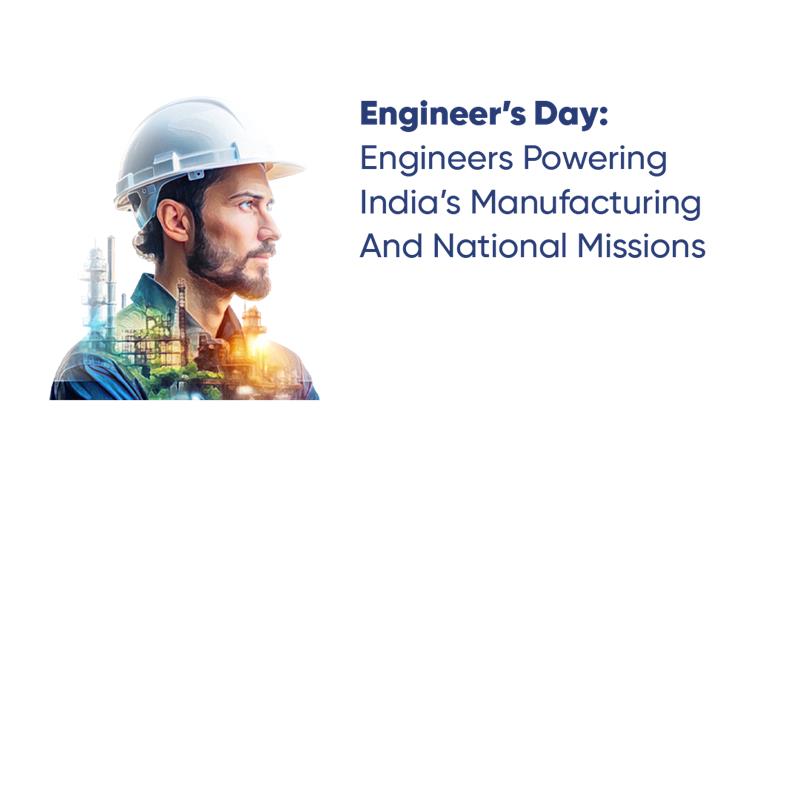Engineer’s Day: Engineers Powering India’s Manufacturing and National Missions
- Engineers are modernizing India’s manufacturing sector by creating scalable, efficient systems that improve productivity and supply chain integration for MSMEs.
- Through R&D in robotics, AI, semiconductors, and advanced materials, engineers are making Indian manufacturing more innovative and globally competitive.
- They are central to national missions like Make in India, Atmanirbhar Bharat, and the semiconductor initiative, reducing import dependence and boosting local design capacity.
- From Chandrayaan-3 to NavIC, engineers in space technology are delivering indigenous solutions with applications in business, logistics, defence, and agriculture.
- Engineers are also building digital financial platforms, such as Protium’s Turiya system, that transform loan processing and expand credit access for MSMEs in Tier-2 and Tier-3 cities.
Engineers play a critical role as manufacturing strength, self-reliance, and high-technology missions remain central to MSME success and government priorities. Their contributions are especially vital for local manufacturers and emerging industries in Tier-2 and Tier-3 towns. This is because India’s push toward a globally competitive manufacturing base and greater technological autonomy depends on engineers who drive innovation and R&D, support national missions like Make in India, Atmanirbhar Bharat (Self-reliant India), and the vocal for local initiative. They also lead in space technology and financial platforms.
As India celebrates Engineer’s Day on 15 September, in honor of Sir Mokshagundam Visvesvaraya, we explore why engineers’ role matters for MSMEs and India’s future.
Engineers Driving Scalable Solutions in Manufacturing
Across India’s industrial clusters, engineers are reshaping how manufacturing is approached. They are designing processes, machines, and tools that enhance efficiency while ensuring reliability. By adapting existing machinery, retrofitting automation, and integrating modern control systems, engineers make it possible for small and medium units to increase productivity without the need for disruptive overhauls. Examples of this include smarter sensor systems and streamlined controllers that improve monitoring and quality control. Many are also enabling the use of renewable energy installations, such as solar or biogas units, which strengthen sustainability and reduce operational bottlenecks. These interventions are not about large, high-cost transitions but about building practical, scalable systems that fit diverse business contexts.
As a result, product quality becomes more consistent, wastage reduces, and delivery schedules become more dependable. This improves competitiveness in both domestic and international markets, while enabling MSMEs to take on larger orders and integrate more confidently into supply chains.
Innovation and R&D: Building Future-Ready Manufacturing
Beyond cost reduction, engineers are pushing India’s manufacturing into future technologies. R&D efforts focus on robotics, artificial intelligence (AI), advanced materials, precision tools, and new manufacturing techniques. Government schemes are encouraging investment in electronic manufacturing, semiconductors, and defence-grade hardware. Engineering institutions, startups, and larger firms are partnering more to move research from lab to factory floor.
One example is semiconductor design and chip fabrication. India has launched policies such as the Design Linked Incentive (DLI) scheme to promote indigenous chip design. Engineers in semiconductor labs are working on chips optimized for Indian needs (including environmental conditions and cost constraints), making Indian products less dependent on imports.
Engineers also act as bridges between academia, government labs (such as CSIR, DRDO, ISRO), and industry. They translate new materials or techniques discovered in academic research into usable industrial processes. For MSMEs, that means access to improved tooling, better monitoring systems, or more efficient energy use. All this adds up to manufacturing that is more precise, more automated, more reliable, and less wasteful.
Engineers and National Missions Like Make in India 2.0
India’s National Manufacturing Mission and related policies such as Make in India 2.0 set targets to increase manufacturing’s share in GDP, boost employment, increase exports, and reduce dependence on imports. While the policy framework provides direction, it is engineers who are turning this vision into reality. Their work extends from designing advanced production lines and introducing automation to ensuring that goods meet international quality benchmarks.
The initiative has spurred major growth across sectors such as automotive, electronics, renewable energy, defence equipment, and textiles, each of which relies heavily on engineering expertise. A key driver has been the Production Linked Incentive (PLI) schemes, which reward manufacturers for scaling production and localizing supply chains. Engineers ensure that factories can meet these demanding output and quality targets by optimizing processes, reducing downtime, and implementing lean manufacturing techniques.
India’s industrial output from manufacturing grew by over 5.8% in 2023–24 compared to the previous year, highlighting the positive momentum building in the sector. Engineers are central to this trend, applying both traditional mechanical knowledge and modern digital tools to create scalable, efficient systems. Importantly, they are also helping MSMEs in Tier-2 and Tier-3 towns adopt the Make in India framework by adapting advanced technologies into affordable, practical solutions for smaller units.
In essence, the success of Make in India rests not just on policy but on the daily problem-solving and innovation of engineers who translate vision into capacity, jobs, and competitiveness.
Self-Reliant India & Vocal for Local
The goals of Atmanirbhar Bharat (Self-Reliant India) and the Vocal for Local movement demand that India reduce import dependence, not only for trivial goods but for critical technologies and components. Engineers are working at upstream and downstream levels: designing machines locally, creating prototypes of circuits and chips, doing precision manufacturing for defence and aerospace, and ensuring a local supply of components.
An example is the recent work by ISRO and the Semiconductor Laboratory (SCL) in Chandigarh, where engineers developed Vikram-32, India’s first fully indigenous 32-bit space-grade microprocessor for launch-vehicle applications. This chip reduces dependency on imported processors for mission-critical applications. It marks progress in the semiconductor mission, which aims for India to become a hub for semiconductor manufacture and design.
Engineers also help MSMEs, artisans, and small workshops by creating low-volume, rugged versions of machinery; making spare parts locally; and customizing designs to local conditions. These local design efforts reduce import costs, foreign exchange drain, and delays caused by shipping and import compliance.
Engineers in Space Tech and Indigenous Systems
India’s space program has long been a source of national pride. Engineers involved in ISRO and partner organizations are expanding India’s capabilities. Missions like Chandrayaan-3, which successfully soft-landed on the Moon’s south pole, show engineering precision and planning.
A critical indigenous system is NavIC (Navigation with Indian Constellation), India’s regional satellite navigation system. It provides accurate real-time positioning data for India and up to about 1,500 km around. NavIC’s growing use in business, defence, logistics, agriculture, ride-hailing, and delivery services means engineers are designing chipsets, receivers, and services around it. For instance, NavIC’s integration into smartphones helps logistics firms improve last-mile tracking, and agriculture firms improve mapping of fields.
Space tech engineers are also pushing ahead with indigenous integrated circuits (ICs) for launch vehicle avionics, especially with recent development of new ICs by ISRO in collaboration with SCL, which reduce cost and import dependence. Moreover, recent space docking experiments (SpaDeX) show India is achieving complex space engineering operations that only a few nations could manage earlier.
These developments enable India to build satellites, launch vehicles, navigational systems, and Earth observation payloads at a lower cost with greater control over design and security, which benefits businesses, defence, and scientific applications alike.
Engineers Building Financial Platforms: An Overlooked but Vital Role
Engineers’ contributions are not limited to physical manufacturing and space. They are transforming financial and credit systems in ways that help MSMEs access finance, manage risk, and grow. One crucial example is Protium Finance and its proprietary engineering platform Turiya.
Turiya is a multi-product, omnichannel loan origination system (LOS) that supports various loan products—from business loans to consumers to equipment finance for MSMEs. It combines algorithmic decision engines with human judgment at critical points in underwriting, striking a balance between speed, customization, and risk control.
Protium has used Turiya to enable loan processing in under five minutes in many cases, helping MSMEs access funds quickly. For MSMEs in Tier-2 and Tier-3 cities, platforms like Turiya matter also because they reduce delays and the need for heavy documentation, offer flexible repayment, and sometimes make approvals available without collateral, or with asset-backing. These improvements in financial systems relieve a major bottleneck for small manufacturers: access to timely credit at reasonable cost. This proves that engineering discipline and risk-aware design can produce reliable outcomes even under pressure
Engineers in fintech, credit platforms, and NBFCs thus provide infrastructure similar to physical infrastructure: enabling workflows, trust, risk control, data pipelines. All of this helps MSMEs invest in machines, build inventory, and scale operations.
Broader Impact: Engineers as Nation-Builders
Engineers are not only building machines, chips, and software, they are also shaping India’s infrastructure, economy, and long-term vision. Engineers are central to transport infrastructure (roads, bridges, ports), in smart cities planning, in energy (renewables, grid modernization), in defence tech and cybersecurity. These fields all have spin-off benefits for MSMEs: better transportation lowers logistics costs; stable power raises manufacturing uptime; secure digital infrastructure enables online markets.
Space missions, too, bring downstream applications. Earth observation satellites help agriculture monitoring; navigation improves transport; satellite communication opens connectivity in remote areas. These ripple effects help business owners in smaller towns.
In defence technology and indigenous systems, engineers provide sovereignty. When sensitive equipment is designed and produced domestically, there is less reliance on foreign sources and fewer risks of supply chain disruption or security vulnerability.
As India aims for Viksit Bharat 2047, the nation needs high productivity, high technology, broad inclusion, and resilient infrastructure. Engineers are the backbone of these goals. For MSMEs especially, engineering solutions make progress tangible in local workshops, in small factories, in towns that are not metro capitals.

